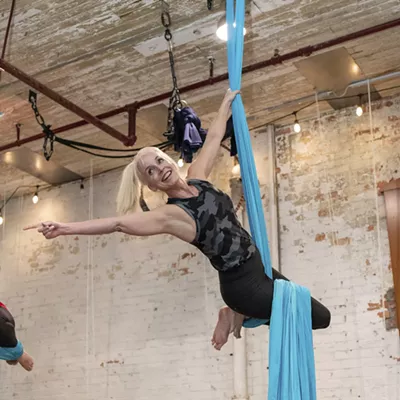When college friends Adam Grosowsky and Jeff Ellington found themselves with free time at a camp in Yosemite Valley during the 1980s, they naturally began to experiment with their climbing gear. By rigging tubular webbing used for rock climbing between two large trees like a tightrope, Grosowsky and Ellington soon were experiencing the area's lush meadows and granite cliffs in a new and interesting way — from above the ground. It didn't take long for others to become intrigued by the novelty and challenge of balancing barefoot on a tensioned line.
"Slacklining" has since spread and evolved into a sometimes daredevil sport that has gained enthusiasts all around the world. Casey White was first introduced to the sport a year ago on campus at Washington State University by a friend and immediately fell in love with it.
"I liked how it was something new. It was difficult at first and made me want to conquer it," White says. As someone who does not identify with the climbing community, White nonetheless found himself benefiting both physically and mentally from slacklining. He says he gains a sense of peace and finds that slacklining helps free him from distractions.
"It helps you get to know your body, because the thing is, if you do something wrong, you have to know what part of your body to correct, and it kind of gets you in tune with your body really fast," White says.
Heidi Peterson, a certified athletic trainer for more than 30 years with university and U.S. national teams, currently splits her days working with athletes at North Central High School and North Spokane Physical and Sports Therapy. Whether her client is a teen or in their eighties, Peterson stresses the importance of good standing posture and balance. While not everyone can walk a slackline, she says she has implemented exercises with similar effects to slacklining into many patients' visits.
"Single-leg and double-leg balancing activities are something that we all should be doing more of," Peterson says. Slacklining takes balance to another level, also helping to counteract poor posture and improve core strength. And you don't have to slackline at dizzying heights to get the benefits of this unique exercise — the balance and strengthening effects can be obtained from walking slacklines not far off the ground, reducing the chance for serious injury. "Slacklining is a way of incorporating total body movements, core control, postural control, postural stabilizers and incorporating the feedback and feed-forward mechanisms," says Peterson.
"It's a fun activity and you're building muscle at the same time," says Lance Jackson, a 29-year-old slacklining enthusiast who has observed the progression and increasing exposure of the sport in the six years he has practiced it. "It works these stabilizer muscles that you don't normally work on a regular basis."
In fact, slacklining may be part of a push toward increased functional activity and less machine use in fitness training. As more labor-saving devices have been incorporated into our everyday lives, Peterson says there's been a decrease in "primal movements," causing people to lose core strength, endurance and control.
Slacklining kits that include all of the gear needed to get started are available, or you can purchase items individually. Traditionally slacklining equipment has been comprised of carabiners, steel links and webbing, which varies by width and length.
Beyond the physical benefits, many slackliners appreciate the meditative-like state they experience while slacklining. "When you first start, it's really challenging," says WSU student Greg Williams, who is in his second year of slacklining despite being afraid of heights. "It's more of a mind concept... you have to tell your mind that you can do it." ♦



















